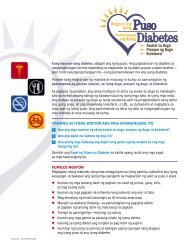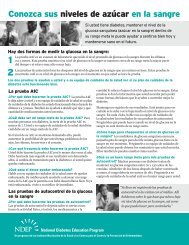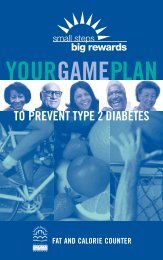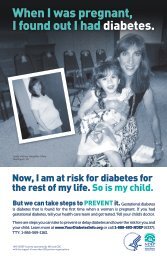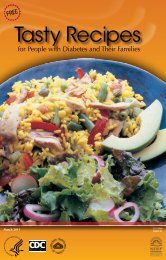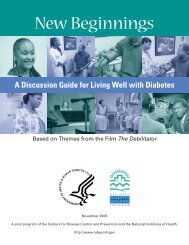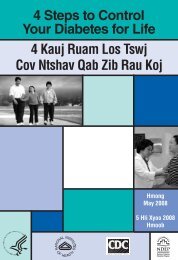Power to Prevent - National Diabetes Education Program - National ...
Power to Prevent - National Diabetes Education Program - National ...
Power to Prevent - National Diabetes Education Program - National ...
Create successful ePaper yourself
Turn your PDF publications into a flip-book with our unique Google optimized e-Paper software.
Discussion Points<br />
Say: “Making changes does not always come easily. But with support and motivation, it can<br />
be easier than you think. In past sessions, we’ve talked about some ways <strong>to</strong> involve<br />
family and friends in healthy eating and physical activity. What are some ways you’ve<br />
involved your family and friends in your lifestyle changes?”<br />
Write responses on a fipchart.<br />
After you have created the list on the fipchart, point out the items that are related <strong>to</strong> talking,<br />
listening, or helping the person through moods, negative feelings, or stress.<br />
Say: “Today we want <strong>to</strong> focus more on helping with feelings, stress, and motivation. Many feelings arise<br />
once a person is faced with having <strong>to</strong> change his or her lifestyle because of an illness. What are some<br />
of the feelings that can come up?”<br />
Note the participants’ responses on a fipchart, making sure that the following points are mentioned:<br />
Denial. Expressions of denial can include not believing that making changes in an unhealthy<br />
lifestyle is important, not believing that diabetes is serious, or not believing that one is at risk of<br />
developing a chronic disease such as diabetes.<br />
Depression. This feeling can show up as a lack of faith in oneself (“I can’t do it!”), fatalism<br />
(“What difference does it make?”), or hopelessness (“Things will never change.”).<br />
Anger. This feeling can show up as anger at oneself (“I can never do it right!”) or at others (“That<br />
stupid doc<strong>to</strong>r!” or “It’s all my husband’s fault.”).<br />
Feeling “stressed out.” This emotion can include feeling unable <strong>to</strong> handle the events of one’s life<br />
well (“I just am so overwhelmed.”).<br />
Say: “Negative feelings can lead <strong>to</strong> negative thoughts such as blaming yourself or others. These thoughts in<br />
turn can lead <strong>to</strong> negative behaviors such as binge eating, or excessive use of alcohol or being unable <strong>to</strong><br />
stick with a <strong>Power</strong> <strong>to</strong> <strong>Prevent</strong> program. Getting family and friends involved with lifestyle changes can<br />
be helpful.”<br />
Go over the list of negative feelings on the fipchart one at a time (denial, depression, anger, stress,<br />
and possibly others identifed by the group) and ask the following questions, listing participants’<br />
responses on the fipchart:<br />
Say: “What is this feeling, and how can it affect your lifestyle changes? How could family or friends help<br />
you <strong>to</strong> move beyond this feeling <strong>to</strong> something more positive?<br />
Having a support system will help you maintain the changes you are making. Family members and<br />
friends can provide encouragement and praise during the ups and downs of improving eating habits<br />
and increasing physical activity. But remember—we can also do things for ourselves that will help us<br />
<strong>to</strong> stay positive while we change our behaviors.”<br />
Hand out copies of Appendix Y: Talk Back <strong>to</strong> Negative Thoughts (one per participant).<br />
NDEP <strong>Power</strong> <strong>to</strong> <strong>Prevent</strong> Session 4



